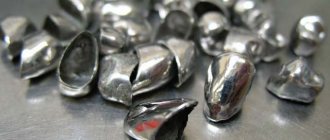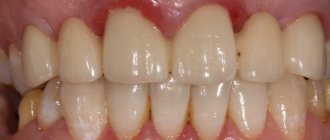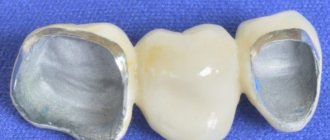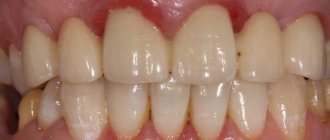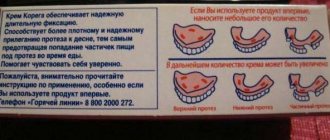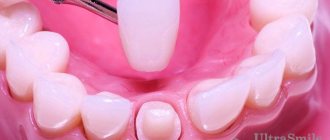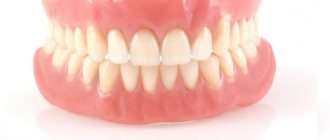Content
- Causes
- What to do if a crown falls out
- What can't you do?
- What to do if you can’t see a doctor right away
- What will the doctor do?
- How to prevent hair loss
The use of modern high-quality and high-tech materials does not make the service life of crowns unlimited. A dental crown has a specific lifespan of 12 years. Sometimes it happens that the crown falls out. Immediately after this trouble, increased sensitivity of the stump may appear. Contact your doctor without delay. If this is not possible, follow your doctor’s recommendations to save the tooth and reduce discomfort as much as possible.
Cream "Korega"
Products from an Irish manufacturer. Provides convenience and comfort throughout the entire period of use, effectively prevents displacement of the prosthesis and allows you to lead a full life without embarrassment and awkwardness.
The composition has many advantages:
- convenient packaging with dispenser;
- dense consistency, most convenient for application and uniform distribution;
- ensures a tight fit and prevents food from getting under the dentures, thereby counteracting infections and bad breath;
- innovative formula without zinc;
- several release options to choose from, including in the form of a cream with a refreshing effect;
- neutral taste, does not change the taste properties of food;
- guarantee of stable fixation for 12 hours;
- when hardened, it takes on a gum shade that is as close as possible to the natural shade.
Before using the cream, the denture should be thoroughly cleaned; the manufacturer produces cleaning tablets specifically for this purpose.
Why is this happening
The following reasons for loss are possible:
- The service life of the cement has expired, the composition has lost its fastening properties - the crown has decemented;
- The patient put too much stress on the crown by including hard foods in the menu;
- During installation, temporary cement was used, which had to be replaced at the appointed time;
- A destructive process was underway under the crown - caries developed, as a result, the tightness of the connection was broken;
- The person often consumed chewing candies and toffees - the viscous consistency of the products contributed to the tearing of the crown from the tooth;
- The crown was placed on a tooth that was too small, and the insufficient tooth height reduced the bond;
- The size of the crown exceeded the size of the stump;
- The tooth stump turned out to be pointed, so the crown was weakly fixed;
- The material used to make the prosthesis was not strong enough.
PROMOTION
Installation of crowns, dental bridge
RUB 3,450
Why is it undesirable to do structural repairs at home?
If, after the prosthesis broke, the patient turned to a specialist, then the repair may take only one to two hours. In this case, only safe materials will be used for restoration.
Self-recovery will not only take more time, but will also create the risk of permanent failure of the structure. In addition, if conventional adhesives such as “Moment” are used for repair, this can lead to poisoning of the body or cause a severe allergic reaction.
What to do if it is not possible to see a doctor immediately
- Apply clove oil to the tooth and the pain will decrease.
- Wash the crown and install it on the tooth using cement, which is sold in the pharmacy chain. It is not advisable to do this, but if you contact your dentist and get the go-ahead, you can fix the product temporarily, according to the recommendations of a specialist. You should first rinse your mouth with an antiseptic.
- If necessary, you can take painkillers.
- If the crown falls off and cannot be found, you can simply lubricate the tooth with pharmaceutical cement - this technique will somewhat reduce the discomfort.
How are broken dentures fixed?
Some patients try to restore the integrity of broken bases or artificial teeth on their own. It only makes sense to do this if it is not possible to see an orthopedic dentist in the near future, and the damaged prosthesis is made of acrylic. Nylon and clasp structures, metal-ceramic crowns and bridges are subject to professional repair only.
The following defects can be eliminated:
- Chip of a small area in the ceramic layer of the crown. The damage site is masked with composite material.
- Loss of one of the crowns of the bridge system. The specialist places the artificial tooth in place.
- Fracture of prosthetic structure fastenings. Damaged locks or hooks can be quickly replaced.
- Linear fracture of the base of a removable denture. To restore the integrity of the structure, special technology is used.
Possible options
If the old crown can be used, it will be reinstalled using fresh temporary dental cement. The patient will have the opportunity to wear the crown again for some time; if discomfort does not arise, the fixation will be performed with permanent cement. If wearing it is impossible, the dentist will offer to make a new crown and give reasons for his recommendations.
Minor damage to the crown (chips) can be repaired. Significant damage cannot be repaired. A new product will need to be manufactured.
Is it possible to put the old crown back?
Sometimes the doctor can replace the fallen crown in its original place. However, treatment tactics depend on the integrity of the prosthesis itself, the type of stump (pin, inlay, implant) and the degree of tooth destruction.
What to do if a temporary crown falls out
Temporary crowns are installed to protect the stump during the production of a permanent prosthesis. They are attached to temporary cement, which is gradually washed away under the influence of saliva. If a temporary plastic or ceramic crown falls out, contact your dentist to have it reinstalled. If this is not done and minimal damage appears on the stump, the permanent crown will not fit tightly and will quickly fall off.
The crown fell out, the tooth is intact
If the patient immediately consults a doctor and there is no caries on the tooth, the cost of installing a fallen crown will be minimal. The doctor will clean the stump and prosthesis from residual cement, and put the old crown in place. Small chips on the prosthesis are polished. If the damage is significant, a new crown is made.
What to do if a dental crown keeps falling out
If the crown falls off more than once, perhaps its size/shape does not match the stump or the installed pin is movable. Contact your dentist at the First Family Clinic of St. Petersburg. An experienced doctor will determine the cause of the prosthesis falling out and make the appropriate correction: in the first case, he will make a new crown, in the second, he will strengthen the support or install an inlay.
The crown fell out along with the tooth
If the tooth breaks off along with the prosthesis, but the roots are not damaged (an x-ray is prescribed for this), it is necessary to create an artificial stump using pins or an inlay, and install a new crown. The second option is desirable, since the tab is more stable than the pin. However, with curved root canals, its installation is impossible.
The crown fell out with the pin
This happens if the pin was installed too short or the patient exceeded the load on the teeth. Bacteria immediately penetrate the root canal. It is necessary to visit the dentist urgently, otherwise a cyst may form. If the pin falls out along with the crown, support for the new prosthesis is created using an inlay, provided that the roots are intact. It is stronger, and therefore will hold the crown better. If the pin is broken (a part remains in the canal) or the roots are damaged, they will have to be removed. The dentition is restored using an implant, bridge or removable denture.
The stump tab with the crown fell out
If the treatment is timely and the roots are not damaged, the doctor will make a new tab. If the roots are cracked or fractured, the tooth is removed and another type of prosthetics is recommended.
Implant installed, crown fell out
Medical tactics depend on the nature of the damage.
- The crown has become loose due to loose threads on the abutment - contact your dentist immediately. The doctor will tighten the screw, otherwise the metal structure may break.
- The crown has fallen off the abutment due to poor-quality cement - to prevent damage to the metal structure of the implant, immediately seek dental help. The doctor will perform the treatment and securely glue the crown into place. If the crown is damaged, a new one is made.
- The crown is cracked - a new one will have to be made. If the abutment is damaged (extremely rare), the screw must be replaced.
- The crown fell out along with the artificial root - this happens if a low-quality system was used, the prosthesis was incorrectly selected, or the installation technique was violated (for example, the implant is too tilted). In this case, the dentist waits for healing and implants a new prosthesis. Osteoplasty is sometimes required. If there is serious damage to the bone tissue, a bridge or removable denture is installed.
Important! Dental implants vary in the size and shape of the abutment and the type of connection. In some models, the screw and root part are monolithic. The patient must know exactly the brand of the implanted prosthesis.
Titanium implants rarely cause allergies. The engraftment process is complicated in patients who smoke, have diabetes, osteoporosis and other diseases. To avoid loss of the titanium root, before implantation, the dentist carefully examines the patient’s medical history and evaluates the possibility of installing an implant.
To ensure that the crown lasts as long as possible, contact dental centers with a good reputation. Read reviews from patients who had crowns installed at the First Family Clinic of St. Petersburg. Our specialists install high-quality dentures of various types and help in cases of loss of crowns.
Does it hurt to remove a crown?
No, especially if the procedure is performed under anesthesia. Removing a crown from a tooth is painful if there is a living tooth underneath it that is undergoing an inflammatory process, but in the vast majority of cases, crowns are placed on pulpless teeth. In such a situation, the procedure may cause some discomfort, but you most likely will not experience severe pain. If your teeth hurt after removing crowns, there are two options. Either mechanical damage has been caused to the gum, or pulpitis, periodontitis or granuloma develops in the tooth. In this case, complex endodontic treatment is required.
Recommendations
If you follow safety measures, you will be able to prevent the occurrence of side effects:
- The glue can be used after your doctor's permission.
- It is important to follow the instructions.
- The product should be stored out of the reach of children.
- Water should not get inside the package.
- The glue is stored with the cap closed and at room temperature.
Thanks to simple rules, it will be possible to protect the body from adverse consequences. If stored incorrectly, its service life will noticeably decrease, so you will need to buy a new product.
Treatment of a tooth under a crown without removing it
In dental practice, there are cases when it is possible to cure a tooth without removing the crown. Usually we are talking about secondary caries and simple endodontic manipulations, carried out through a hole, which is then filled with a composite material. In some cases of surgery, such as cyst removal, the surgical site is accessed through an incision in the gum. In this case, the product usually still has to be removed for additional manipulations.
Cement
Another way to glue a dental crown at home? For this, another effective remedy recommended by dentists can be used. This is a dental cement that can retain its properties for over 10 years. But permanent cement is not intended for home use. Installing a crown yourself can only be done using a temporary solution. Its fixation period is longer than that of glue. But you need to be careful not to overdo it and ruin the prosthesis, since excess dental cement can make it unsuitable for subsequent procedures.
Before purchasing, it is still better to consult a doctor about which product is best to choose. Cement for dental crowns is not sold in every pharmacy. Moreover, there are both cheap and expensive options. Cement "Provicol" and "Meron" cost over 1,500 rubles. They include 2 components that must be mixed before use. Cheap products include zinc phosphate cements - “Adgezor”, “Unifas”, “Unitsem”. The cost for them is no more than 300 rubles per package. And “Tsemion F” costs about 350 rubles. When choosing any product, you need to find out about compatibility with the crown.
How are crowns removed from teeth?
There are several ways to remove dental crowns.
Sawing
An old and rather crude way. After this, it is no longer possible to remove the crown and put it back. The technique is considered cheap and quite effective, but the final success largely depends on the experience of the doctor - a tooth or gum may be damaged in the process.
Removal using a Kopp apparatus
The Kopp apparatus is a special tool that resembles both a refueling nozzle and a hook (due to the hook-shaped nozzle). The doctor grinds off the cement at the base of the crown, then picks it up with a tool and presses the release. This is a fairly quick and effective method with the only drawback - during the extraction process, chips of the prosthesis may occur.
Ultrasonic crown removal
Involves destruction of cement using ultrasound. The method is well suited for removing old crowns. However, if the material is too dense and strong (for example, glass ionomer cement), ultrasound may not be able to cope with it.
Removal using the Coronaflex device
The operation of the Coronaflex device, which looks like a pistol from the future, is based on the principle of compressed air. The air flow is supplied under high pressure, destroys the cement, but at the same time has a gentle effect on the crown and adjacent tissues. Removing a prosthesis using a device will cost significantly more than other methods. However, if you have a zirconium crown costing 25,000 rubles, it makes sense to overpay a little.
Rules of conduct when a bridge falls out
What to do if a dental bridge falls off? Often people get lost and don’t know how to behave. Someone almost begins to panic, someone hastily throws the fallen orthopedic structure into the trash. The list below includes simple and understandable rules that will tell you what to do when a dental bridge falls out:
- carefully spit everything out of your mouth onto a napkin if it falls out while eating,
- rinse your mouth with water and then with some solution (chlorhexidine or mouthwash),
- rinse the bridge in clean water, you can clean it with a soft bristle brush: when rinsing and cleaning, make sure that it does not fall into the sink or onto the floor,
- place the prosthesis in a clean handkerchief or piece of sterile bandage,
- put the bridge in a small, clean container so as not to accidentally break the product (in case it can be glued back, although this is unlikely). You will need to take the prosthesis to the clinic in the same container,
- try not to chew on the “affected” side, and also rinse your mouth after each meal (if there is still a lot of time before your visit to the clinic).
When the bridge falls out from clenching the jaws, from pressing with the tongue - that is, when there was no food in the mouth, then immediately go to point number “2” of this list.
If it suddenly turns out that the bridge was swallowed along with food or liquid, then you need to immediately contact a clinic - for example, a therapist, pediatrician, or a hospital emergency room. The sharp edges of the structure can injure the gastrointestinal tract; the bridge can get stuck in the esophagus or intestines. Therefore, you will need to undergo an x-ray or ultrasound. It is important not to make active movements, not to bend over and to adhere to the diet prescribed by the doctor - so that the structure leaves the body naturally. Otherwise, you will have to undergo emergency surgery.
Causes of structure failure
Can a dental bridge fall out immediately after installation? The reasons that a permanent dental bridge falls off after a few days, weeks (less often, months) most often lie in errors in its manufacture or fixation. But the patient’s own fault may also be present here. Let's take a closer look at the factors that cause loss in the early period:
- the use of low-quality cement or its incorrect application,
- the presence of a gap between the inside of the prosthesis and the supporting teeth on which it is placed,
- caries under crowns: this may be undetected caries - it was not noticed during preparation for prosthetics. Or when the supporting tooth was overheated during turning. If, during the passage of root canals, they are poorly processed or sealed, then over time this leads to the spread of infection,
- allergy to prosthetic materials,
- if the patient chewed something very hard with his teeth (including artificial ones), chewed toffee, toffee.
Another reason for loss is poor oral hygiene, when a large amount of plaque and stone accumulates around the crowns. This in itself can lead to the destruction of the ceramic or composite coating of the bridge and partial crumbling of the cement composition. If we consider that dental deposits are inhabited by bacteria that have a negative effect on the gums and roots of the teeth under the prosthesis, then loss can occur due to progressive caries on the supports.
When can a broken denture be repaired under warranty?
All orthopedic structures have a warranty period of use. It ranges from one to two to five to eight years. The warranty on high-tech types of dentures can reach 10–15 years. During this time, the clinic undertakes to correct damages and defects caused by violations of manufacturing technology or other factors for which a particular dentistry is responsible.
But in some cases, repairs and restoration under warranty are not possible, even if the period has not yet expired. Such situations include:
- A fall of a removable denture, causing it to break or chip.
- Impact of solid objects, injury to the area where the structure is installed.
- Poor care of the prosthesis, due to which the surfaces are covered with a coating that is difficult to wash off.
- Damage to the base, retainers or crowns due to exposure to high temperatures, for example when treating with boiling water.
With proper care of dentures and careful use of them, all damage will be repaired free of charge, unless the warranty period has expired.
Feeling discomfort from the prosthesis
It is also possible to feel discomfort in the mouth after installing a denture:
- Problems with pronunciation.
- Increased salivation.
- A feeling of something foreign in the mouth.
- Rubbing of the gums and the inside of the cheek.
Usually these phenomena go away after 10–15 days, but if the discomfort persists for a long time, you should go to a specialist for a more precise fit of the prosthetic structure and eliminate problems with dental prosthetics.
Terms of use
A dental crown can solve the problem of tooth loss, but it can fall out at any time. In this case, glue will help, but it must be used correctly so as not to harm yourself. To do this, follow the instructions for use:
- The fallen denture must be cleaned of food, plaque and old glue. Use dental floss or a brush for cleaning. If cleaning is performed above the sink, you must first plug the drain hole so as not to lose the crown.
- Then you need to brush your teeth, especially the one from which the crown was removed. Unpleasant sensations may appear, since the tooth has been ground down and will be very sensitive. This phenomenon is considered normal. Don't press it too hard. It is desirable that the brush has soft bristles.
- The cleaned crown and tooth must be dried. Sterile gauze is used for this purpose. A bandage is suitable instead. You should wipe the surface of the tooth and crown carefully to avoid any unpleasant sensations.
- A small amount of glue is applied to the crown and then installed in the desired location. During the entire process, it is necessary to monitor actions through the mirror. This makes the work much easier. If the crown was in a hard-to-reach area, the procedure must be performed with someone's help.
- After installing the crown, you need to slightly clench your jaws. This is necessary to determine whether the prosthesis is installed in the desired position. This position must be held for 1-2 minutes until the glue dries. The wait may be less, it all depends on the means.
- Using dental floss, you need to carefully remove any remaining adhesive from your teeth. It is important that the movements are smooth and not forceful so that the crown does not fall out. This completes the procedure.
Glue selection
Depending on the individual characteristics of the patient, the doctor may prescribe a specific adhesive for dental crowns. But you can choose the remedy yourself, testing different options. This is how their quality is checked and sensations are observed. As a result, a suitable option will remain.
There are 3 types of dental crown adhesives produced by pharmaceutical companies:
- Viscous.
- Medium viscosity.
- Liquid.
The latter option costs more, but is more often chosen by people who have recently had crowns installed. The reason for this is ease of use. But gradually many people acquire viscous compositions, since liquid ones take a long time to dry.
Patients do not immediately get used to wearing a prosthesis, so in the first time after installation, changes in the perception of taste may be noticeable. In order not to aggravate the situation, experts advise not to use products with fragrances until you become accustomed to the foreign body.
Some manufacturers confidently believe that their products provide fixation for half a day, and sometimes more. But there are factors due to which the duration of fixation is noticeably reduced. This arises from laughter, food composition, food consumption. According to statistics, almost every crown adhesive lasts no more than 9 hours. this indicator varies depending on the quality of the product.

